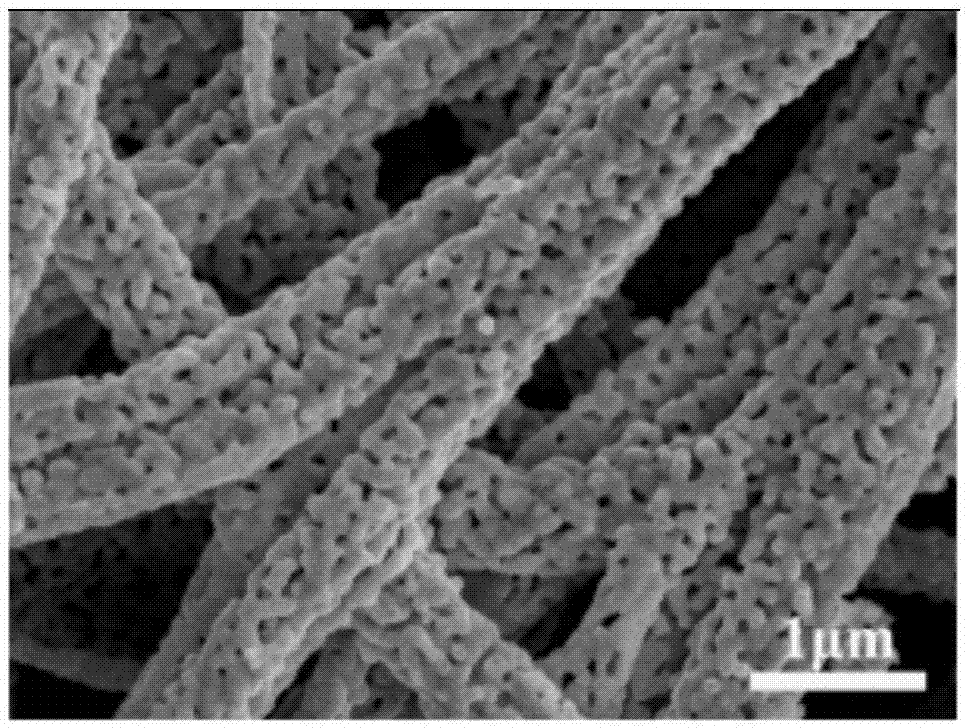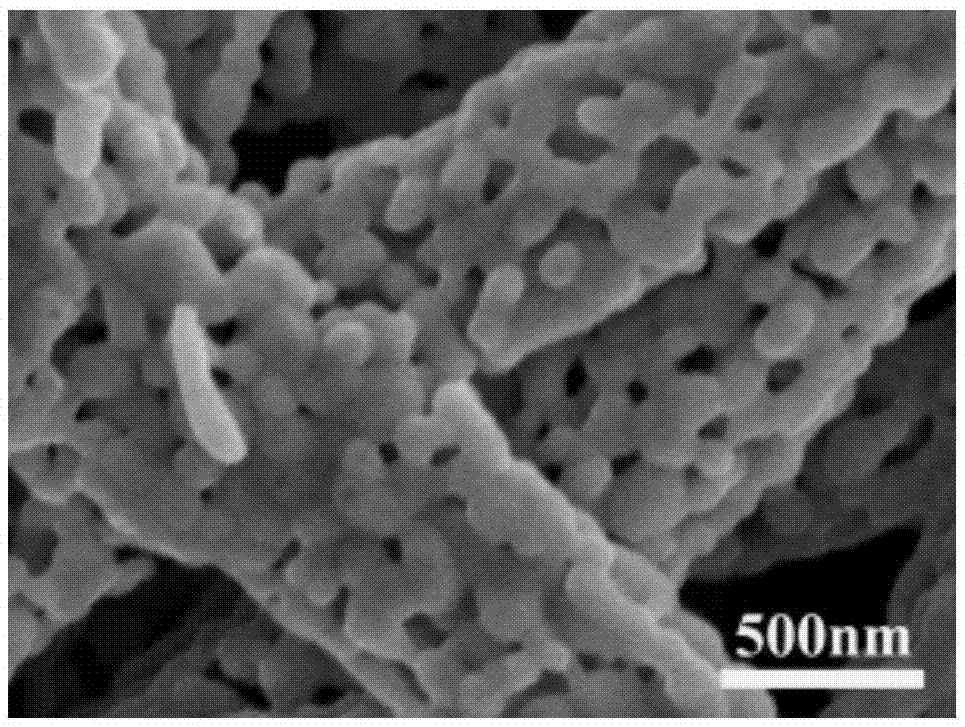BiVO4 full-mesoporous fiber material efficient photocatalyst
A fiber material and photocatalyst technology, which is applied in the field of BiVO4 full mesoporous fiber material high-efficiency photocatalyst, can solve the problems of low conduction band, inability to meet reduction potential, fast electron-hole combination rate, etc., and achieve the effect of improving electrical conductivity.
- Summary
- Abstract
- Description
- Claims
- Application Information
AI Technical Summary
Problems solved by technology
Method used
Image
Examples
Embodiment 1
[0033] Weigh polyvinylpyrrolidone (PVP) 0.7g (10%), bismuth nitrate pentahydrate (Bi(NO 3 ) 3 ·5H 2 O) 1.21g (17.3%) and vanadyl acetylacetonate (VO (acac) 2 ) 0.662g (9.5%) was dissolved in a mixture of 2.5g absolute ethanol, N-N dimethylformamide (DMF) 2.5g and 2g glacial acetic acid, stirred and mixed with a magnet for 6 hours at room temperature to obtain dark green Clear solution. Measure 6ml of the solution to be spun and inject it into a plastic needle tube, place it on a micro-injection pump, and set the injection speed to 0.2mm / min. The metal needle is used as the electrospinning anode, and the aluminum foil-coated roller is used as the cathode of the receiving material. The distance between the anode and the cathode is 20 cm, and electrospinning is carried out under 12kV high voltage (the environment during spinning is room temperature (20-30°C) ), humidity: 50-60%), and prepare the organic precursor fiber material. Then place the organic precursor fiber materia...
Embodiment 2
[0035] Weigh 0.7 g of polyvinylpyrrolidone (PVP), bismuth nitrate pentahydrate (Bi(NO 3 ) 3 ·5H 2 O) 1.21g and vanadyl acetylacetonate (VO(acac) 2 ) 0.662g is dissolved in the mixed solution of 2.5g dehydrated alcohol, N-N dimethylformamide (DMF) 2.5g and 2g glacial acetic acid, adds 0.5g diisopropyl azodicarboxylate ( Foaming agent, DIPA) and continued stirring to obtain a light brown-green transparent solution. After the microemulsion to be spun was left to stand, 6ml was measured and injected into a plastic needle tube, and placed on a micro-injection pump, and the injection speed was set at 0.2mm / min. The metal needle is used as the electrospinning anode, and the barbed wire is used as the cathode of the receiving material. The distance between the anode and the cathode is 20 cm, and electrospinning is carried out under 12kV high voltage (the environment is 30°C during spinning, humidity: 50-60%), Preparation of organic precursor fiber materials. Then, the organic pre...
Embodiment 3
[0037] Weigh 0.7 g of polyvinylpyrrolidone (PVP), bismuth nitrate pentahydrate (Bi(NO 3 ) 3 ·5H 2 O) 1.21g and vanadyl acetylacetonate (VO(acac) 2 ) 0.662g is dissolved in the mixed solution of 2.5g dehydrated alcohol, N-N dimethylformamide (DMF) 2.5g and 2g glacial acetic acid, adds 1.06g diisopropyl azodicarboxylate ( Foaming agent, DIPA) and continued stirring to obtain a light brown-green transparent solution. After the microemulsion to be spun was left to stand, 6ml was measured and injected into a plastic needle tube, and placed on a micro-injection pump, and the injection speed was set at 0.2mm / min. The metal needle is used as the electrospinning anode, and the barbed wire is used as the cathode of the receiving material. The distance between the anode and the cathode is 20cm, and electrospinning is carried out under 12kV high voltage (the environment is 40°C during spinning, humidity: 30-40%), Preparation of organic precursor fiber materials. Then, the organic pre...
PUM
 Login to View More
Login to View More Abstract
Description
Claims
Application Information
 Login to View More
Login to View More - Generate Ideas
- Intellectual Property
- Life Sciences
- Materials
- Tech Scout
- Unparalleled Data Quality
- Higher Quality Content
- 60% Fewer Hallucinations
Browse by: Latest US Patents, China's latest patents, Technical Efficacy Thesaurus, Application Domain, Technology Topic, Popular Technical Reports.
© 2025 PatSnap. All rights reserved.Legal|Privacy policy|Modern Slavery Act Transparency Statement|Sitemap|About US| Contact US: help@patsnap.com



